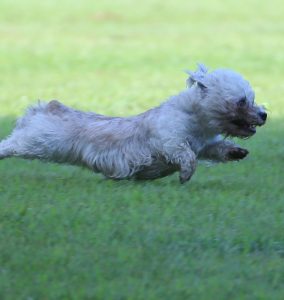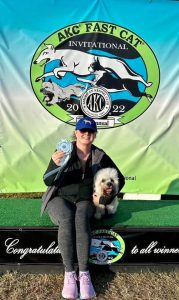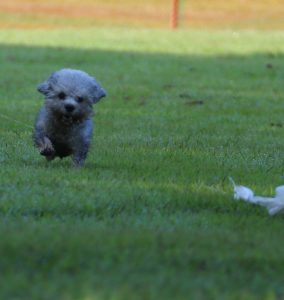Fast CAT®
If you’ve ever wondered how good your Dandie’s natural abilities are, you might consider a low-stress, non-competitive test where each dog runs individually to measure performance.
Fast CAT® – which stands for Coursing Ability Test – is a timed 100-yard dash where dogs run one at a time, chasing a lure. It’s over before you know it — and it’s nothing short of awe-inspiring to watch your dog run at top speed, ears back, eyes focused, legs strong. And if your Dandie is really fast, you might earn bragging rights if their name makes onto our list of the top 20 fastest Dandie Dinmont Terriers! All dogs can participate in Fast CAT, whether purebred or mixed breed.
Although it is a relatively new sport, it has grown quickly. According to one AKC official, “The Fast CAT® provides a terrific opportunity to introduce new participants to the world of AKC sports as one of the few events where all that is needed to compete is a dog’s natural instincts.”
AKC Coursing Ability Tests do not require dogs to run as far as dogs in lure coursing trials.They also do not have to execute extreme turns, with no turn being more acute than 90 degrees.
Eligibility
To compete, your dog must:
- Be 12 months or older
- Have an AKC number via one of the following:
- AKC registration as one of the recognized breeds.
- Spayed females and neutered males are eligible to participate.
- Females in season are not eligible to participate.
There’s not much you need to do to prepare for your first CAT besides get your dog in shape! You can also play with him often by giving him things to chase in your yard like plastic bags on a windy day, or toys and balls to run after. Just get him used to seeing something and chasing after it. As with all Coursing Ability Tests, the goal is not to harm any living animals so make sure you don’t encourage him to chase after any squirrels or other creatures running through your yard.
Lure Coursing
The American Kennel Club recently created a new event that allows all dogs to discover the excitement of lure coursing. The AKC is allowing non-sighthounds to title in the sport. Not only is coursing fun, it offers many other benefits ranging from exercise to a remedy for boredom.
The Coursing Ability Test (CAT) is for any dog of any breed, including mixed-breeds, as long as it is at least 1 year old and individually registered or listed with AKC. To pass the test, a dog running alone must pursue a lure, completing the course with enthusiasm and without interruption within a given time.
Dogs under 12-inches at the withers have a course of approximately 300 yards. Dogs more than 12 inches at the withers race approximately 600 yards. The 600-yard course must be completed within 2 minutes and the 300-yard course within 1½ minutes.
Lure coursing often requires no training. Many dogs see the lure move and immediately want to chase it. Some dogs need practice and some coaxing, but eventually, with repetition, they respond. If your dog has already displayed a pretty strong prey drive by being attracted to squirrels or wild birds or other small animals, their chances of liking the lure are higher.
Dogs that pass the CAT three times will earn a Coursing Ability (CA) title. Ten passes and a dog earns a Coursing Ability Advanced (CAA) title, and 25 passes results in a Coursing Ability Excellent (CAX) title. Licensed lure coursing clubs may hold CATs in conjunction with a licensed lure coursing trial or as a standalone event.
For those of you who plan to give the test a try with your Dandie, here are some tips:
- Make sure that your Dandie is physically healthy and in good shape to run a course. If you are not sure, make an appointment with a veterinarian to get an opinion.
- Take your dog to a practice to introduce your Dandie to the lure or make your own lure for practice. “If you cannot get to a practice, you can try to play tug with your dog with a plastic bag or another type of lure pole. This is similar to what is used to play with a cat, but on a dog level. You can get a type of plastic lure and attach it to a springing pole and have your dog practice chasing it around your yard or a nearby park, on leash, or course.”
- For the test, bring lots of fresh water, a strong, soft leash, and maybe a portable crate if the lure field is a long ways from the car.
- Handlers should wear comfortable shoes and be physically able to hold and release their dogs, as well as catch them.
- Teach your dog the command “come.” “If you don’t have control over the dog when it is just laying around the house and not fully aroused, you will have a heck of a time trying to catch them when they are super excited about the lure and running loose.”



